












 |
Our Women in the War
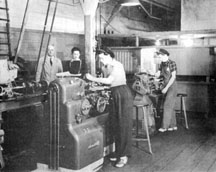
(An Editorial from the Eastern Chronicle, Thursday, May 25th, 1943) The man on the street invariably feels like doffing his hat as a distinctive measure of respect for the women in military uniform, regardless of whether her allegiance is to the army, navy, or air force, or that she is a nursing sister in the Red Cross service. You know that she has offered her services for the success of the war. She many not be in the firing line, but is as close to is as her orders carry her. You realize that she is taking the place of some soldier, naval man, or air man, anxious to actively participate in the life or death struggle at the front. She is doing her bit, and doing it well.
But there is another woman in the war service that seldom gets the notice she deserves. She is a war worker in one of the large industries. She is taking the place that formerly was deemed exclusive for men. She is just as essential for the success of this global war as almost any of her sisters.
Recently, we had the privilege of visiting the Gunshop at the busy plant of the Trenton Industries. Walking down the long alley in the center of the shop, on either side were men and women manipulating intricate machines that were cutting and shaping steel for the fabrication of these essential guns for the protection of the armed forces. On was not surprised at the men. Some were trained machinists and they were skilled in such work. They had a job to do and were doing it well. But what impressed us was the skill with which girls did this work. In a sense, it looked foreign to them, but they appeared to be as much at home at the work as their brothers.
Here was a little petite girl, snugly dressed, handling callipers, gauges, micrometers, cutters, files, wrenches and levers with truly amazing skill. From the rough block of steel, she was shaping a section of the great gun equipment. Her work called for delicate precision. The cutting was in the thousandths part of an inch. It required the closest attention. It was surely an intricate task. Yet the girl was not rattled. She was as cool as the proverbial cucumber. She concentrated on the job that was hers, and knew that the least error would spoil the thing. She wasn’t taking any chances. She had a job to do and she was doing it. It was no play task. Nothing could be left to chance. Soon an inspector would come and scrutinize the finished job. It had to be perfect in every regard. There was no leeway, no margin for error. There was a particular place on that gun in which it must fit, and fit with utmost precision. Looking on, one wondered at her definite skill and composure; and too, wondered how very important her task was. It was a component part of that fine gun that would sooner or later go into action. That it should work perfectly in all regards probably would depend on the life of many of the brave boys at the front, or on the high seas. Under fire they put their trust in the perfect operation of that gun.
These young girls had a personal responsibility in the correctness of their work. They were the “men behind the gun”. They did not sport brass buttons, or shoulder plates. A small disc, with a number place, alone designated them in their job. Each one of those girls and men down that long row of busy machines were doing a tremendous job. They were essential to the great struggle for freedom, liberty and peace. They were an integral part of the great fighting forces of empire, for without them there would be no guns, or fewer, to wage the terrific conflict that will ultimately pronounce the victory, and assure peace in this strife-torn world.
In its rough way, this old paper would tender its humble appreciation to these men and girls who have made this War effort their duty. Though miles from the actual front, they are heroes in this War. Our hats are off to these girls and men of the Trenton Industries. They are standing in the life-line of the nation, and no one could hold a more honourable place.
|
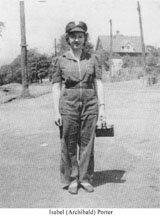 |
History traditionally has been written by men, about events centering on the experience of men. So historians have viewed women’s history as unimportant!
During World War II, women went from the home into non-traditional work places with little or no training and background and in great numbers. Many left the comforts of home for the world of independent self-supported living. For some men and women, seeing women go to work in what was traditionally considered man’s work must have been disturbing, where as others welcomed it.
|
Women were interviewed and “psychological” tests much like aptitude tests were given. If the people were considered appropriate for the anticipated work, they were then permitted to enter into a probationary training period, for which they were paid. In Trenton, many of the women in the Gun Shop were trained in the Machine Tool operation at the Eastern Car Company. This was one of the five training facilities in the province. Women who completed the two-week probationary period were then trained for a further two to four weeks. Those who were considered not to possess the natural abilities required for the job were asked to leave at the end of the probationary period.
During their training, women were taught how to operate machines through the day and at the end of each day were required to spend an hour in the classroom studying theory, decimals, micrometer reading etc. The Department of Labour stated that employment preference be given first to Veterans of the First World War, then to those discharged from the present war and finally to those who had been rejected for service for being physically unfit.
The women were happy to get the work, and when it ended, bowed out gracefully with the belief that other work would have to be sought. The entrance of women into these industries had been an exception to the rule, a situation which had been rectified quickly after there was no longer need for their services. Although we paid dues to a union, they had little to do with us. There were a few strikes, (lasting only a day) the workers usually returned to work pending settlement. The Federal Government had control of employment during the war period and unions had little or no influence on it’s decisions.
One woman joked “Sometimes you wondered what you were doing there – payday overcame – (12 hour shifts)”.
|
(Following taken from J. O’ Halloran’s publication) In the fall of 1942 we started employing female machine operators for some of the lighter machines and at the present time approximately 25% of our machines are operated by them. There operators received a short preliminary training in the Nova Scotia Training School on the same classes of machines on which men were previously trained. The work which has been turned out by the female operators has been quite satisfactory and they are now running many different types of machine tools apart from the ones on which they received their initial training.
“I came to T.I.L one day, I came on one condition
To help them here to make the guns – to shoot the ammunition.”
|
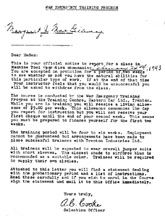
|
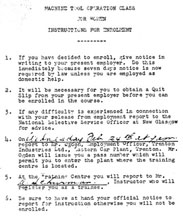
|
We went to work at eight in the morning – fifteen minute rest period at 10, and a half a hour for lunch. At quarter to three, we cleaned up our machines, swept up any chips that escaped to the floor. Then for an hour’s teaching from Mr. Hamilton on Tuesday and Thursday and Mr. Arkwright on Monday, Wednesday and Friday. Mr. Hamilton taught us decimals, fractions etc. while Mr. Arkwright taught us about metals, verniers etc. – and after six weeks of learning we were placed in different parts of the shop.
The girls in second class were: Bessie Reid; Elsie Johnstone; Marie Robson; Doris Woolley; Jean Murray; Agnes Mason; Isabel Archibald; Grace Fisher; Laurina Wilson; Netty Fleming; Shirley Pelley; Theresa MacDougall; Anne Robertson; and Margaret J. MacGillivray.
Bessie Reid, Elsie Johnstone and Margaret MacGillivray graduated in five weeks. Elsie Johnstone and I were put on Turret lathe #70 in the dungeon – after fluorescent lights were installed it was renamed “Hollywood”.
In our machines we used carbide tipped tools. Different tools for copper, brass, bronze and steel. Our foremen were: Bob MacGunnigle, Bob Hale and Ed Boutilier. About 250 girls worked 3-8 hour shifts and for a while 2-12 hour shifts.
Our pay for training was, single $9 a week, married with family $13.50 per weeks. When we “graduated” to the floor – we made 36 cents per hour, married with dependents 44 cents per hour. In 1943 my hourly wage was 66 cents per hour.
My board was $3.00. Others paid $5.00 plus our bus fare was 10 cents a trip
My pay cheque read:
|
|
Period ending Feb 23, 1945
Margaret MacGillivray M.O.
#5770
35 ½ hours @ .66 =
Defence tax
Hospital
Union
U.I.C.
Bond
Balance
|
$23.43
2.85
.75
.25
.30
$8.00
$11.28
|
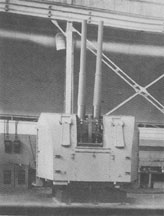 |
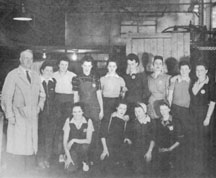
|